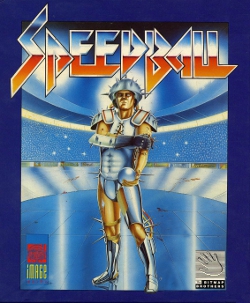
Speedball is a 1988 video game based on a violent futuristic sport that draws on elements of handball and ice hockey, and rewards violent play as well as goals.
ERE Informatique was one of the first French video game companies, founded in 1983 by Emmanuel Viau, joined a year later by Philippe Ulrich. The company hired freelance game programmers that received royalties for their creations.

The Sentinel, released in the United States as The Sentry, is a puzzle video game created by Geoff Crammond, published by Firebird in 1986 for the BBC Micro and converted to the Commodore 64, Amstrad CPC, ZX Spectrum, Atari ST, Amiga and IBM PC compatibles. The Sentinel was among the first games to use solid-filled 3D graphics on home computers. It won numerous awards upon release and has since appeared on several "best video games of all time" lists.

Commander Blood is a science fiction adventure game that was developed by Cryo, a French company that also created Captain Blood. Designed to run on MS-DOS, Commander Blood was released in 1994. The Big Bug Bang, the sequel to Commander Blood, was released in 1996, and was available in French only.

B.A.T. is a futuristic point and click adventure game with some role-playing video game elements. It was first released in 1989 and available on several home computer platforms, mostly in 1990 and 1991. It was developed by Computer's Dream and published by Ubisoft. A sequel, B.A.T. II – The Koshan Conspiracy, was released in 1992.
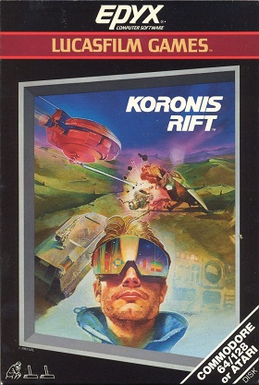
Koronis Rift is a video game from Lucasfilm Games, produced and designed by Noah Falstein. Originally developed for the Atari 8-bit computers and the Commodore 64, Koronis Rift was published in 1984. It was ported to the Amstrad CPC, Apple II, MSX2, Tandy Color Computer 3, and ZX Spectrum.
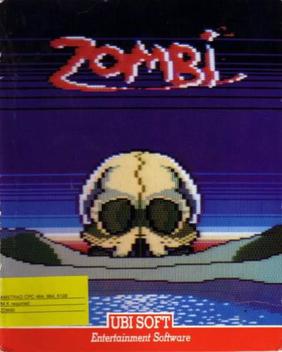
Zombi is an icon-driven action-adventure video game. It was Ubisoft's first publication, released in 1986. It was programmed by Yannick Cadin and S. L. Coemelck, with graphics by Patrick Daher and music by Philippe Marchiset.

Bubble Ghost is an action video game created by Christophe Andréani for the Atari ST in 1987. The player controls a ghost who by blowing guides a floating bubble throughout a number of halls in a haunted house, while avoiding obstacles that can make the bubble pop.

Hacker II: The Doomsday Papers is a video game written by Steve Cartwright and published by Activision in 1986. It is the sequel to the 1985 game Hacker. Hacker II was released for the Amiga, Apple II, Apple IIGS, Amstrad CPC, Atari ST, Commodore 64, IBM PC compatibles, Mac, and ZX Spectrum.

Hostages is a 1988 tactical shooter video game developed and published by Infogrames for the Acorn Electron, Archimedes, Atari ST, Amiga, Apple IIGS, Amstrad CPC, BBC Micro, Commodore 64, MS-DOS, MSX, Nintendo Entertainment System, and ZX Spectrum. The game depicts a terrorist attack and hostage crisis at an embassy in Paris, with the player controlling a six-man GIGN counterterrorist team as they are deployed to defeat the terrorists and free their hostages.

Moebius: The Orb of Celestial Harmony is a video game produced by Origin Systems and designed by Greg Malone. It was originally released in 1985 for the Apple II. Versions were also released for the Amiga, Atari ST, Commodore 64, Macintosh, and MS-DOS. The game is primarily a top-down view tile-based role-playing video game, but it has action-based combat sequences which use a side view, roughly similar to games such as Karateka.

Archipelagos is a 1989 first person action and strategy video game developed by Astral Software and playable on Amiga, Atari ST, and MS-DOS.

Test Drive is a racing video game developed by Distinctive Software and published by Accolade, released in 1987 for the Amiga, Atari ST, Commodore 64, and DOS, in 1988 for the Apple II, and later ported for the PC-98 in 1989. It is the first game in the Test Drive series.
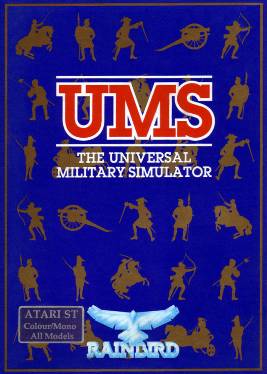
The Universal Military Simulator is a computer game developed by Rainbird Software in 1987 for the Macintosh, Tandy 4000, and IBM PC compatibles. In 1988, both Atari ST, Amiga versions were released. The game was created by Ezra Sidran. The PC and Amiga versions were ported by Ed Isenberg. The game spawned two sequels: UMS II: Nations at War and The War College: Universal Military Simulator 3.

Final Assault, known as Chamonix Challenge in Europe, originally Bivouac in French, is a mountaineering simulation distributed by Infogrames and Epyx in 1987 for the Amiga, Amstrad CPC, Apple IIGS, Atari ST, Commodore 64, MS-DOS, Thomson and ZX Spectrum. The original release of the game was copy protected.

Transylvania is an adventure video game published by Penguin Software. It was released for the Apple II in 1982 followed by ports to the Atari 8-bit computers and Commodore 64. A Mac conversion was published in 1984, then versions for the Amiga, Atari ST, and MS-DOS in 1985.

Ogre is a 1986 video game based on the Ogre board wargame. It was released by Origin Systems for the Apple II, Amiga, Atari 8-bit computers, Atari ST, Commodore 64, MS-DOS, and Mac.
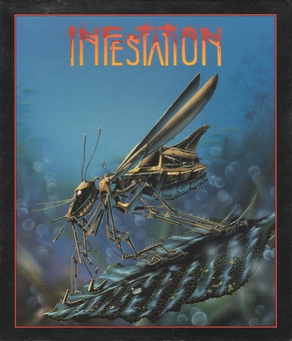
Infestation is a first-person action-adventure game released in 1990. The game was published by Psygnosis and released for the Amiga, Atari ST, and DOS. Based on a science fiction scenario inspired in part by the films Alien and Aliens, the player must rid a planetoid of insectoid alien life forms.
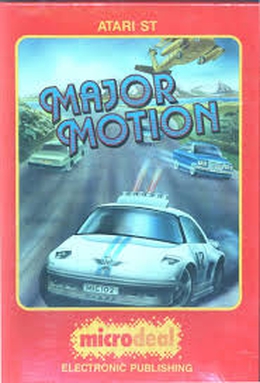
Major Motion is a video game written for the Atari ST by Philip McKenzie and Jeffrey Sorenson and published by MichTron in 1986. An Amiga version followed in 1988. Major Motion is a clone of the Spy Hunter arcade game.

Phoenix is a single-player first-person space flight shooter released in 1987 by ERE Informatique for the Atari ST. It was later published by Infogrames for the British market. The game consists of piloting a spaceship across hyperspace routes represented by colored wireframe tiles created with vector graphics while shooting hostile gun turrets and black holes.




















